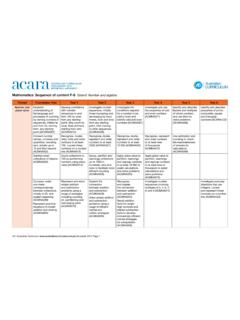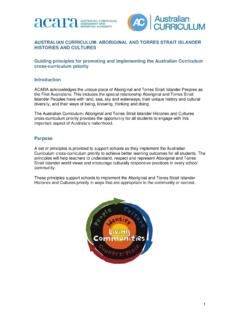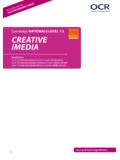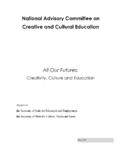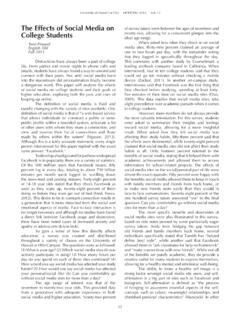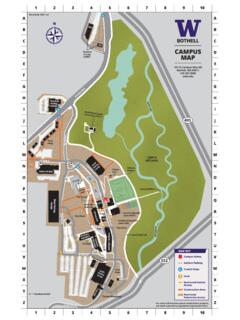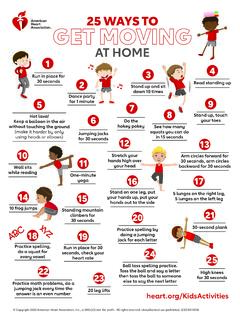Transcription of National Literacy Learning Progression - Australian Curriculum
1 COPYRIGHT The National Literacy Learning Progressions are licensed under a creative commons Attribution-NonCommercial International (CC BY-NC ) licence. See ( ). You are free to share (copy and redistribute the material in any medium or format) and adapt (remix, transform, and build upon) these materials for non-commercial purposes only, provided you attribute ACARA. See attribution notice under our Copyright and terms of use ( ). For the avoidance of doubt, this means that you must not use these materials for commercial purposes. National Literacy Learning Progression COPYRIGHT The National Literacy Learning Progressions are licensed under a creative commons Attribution-NonCommercial International (CC BY-NC ) licence. See ( ). You are free to share (copy and redistribute the material in any medium or format) and adapt (remix, transform, and build upon) these materials for non-commercial purposes only, provided you attribute ACARA.
2 See attribution notice under our Copyright and terms of use ( ). For the avoidance of doubt, this means that you must not use these materials for commercial purposes. Contents What is Literacy ? .. 3 What is the focus of the Literacy Progression ? .. 3 How is the Literacy Progression structured? .. 3 How is the Literacy Progression related to the Australian Curriculum ? .. 6 How can the Literacy Progression be used? .. 6 How does the Literacy Progression cater to students for whom English is an additional language or dialect? .. 7 Speaking and listening .. 8 Listening .. 8 Interacting .. 10 Speaking .. 12 Reading and viewing .. 16 Phonological awareness .. 16 Phonic knowledge and word recognition .. 18 Fluency .. 21 Understanding texts .. 23 Understanding texts .. 29 Writing .. 31 Creating texts .. 31 Informative text indicators.
3 37 Persuasive text indicators .. 37 Imaginative text indicators .. 37 Informative text indicators .. 41 Persuasive text indicators .. 41 Imaginative text indicators .. 41 Grammar .. 46 Punctuation .. 50 Spelling .. 52 Handwriting and keyboarding .. 56 COPYRIGHT The National Literacy Learning Progressions are licensed under a creative commons Attribution-NonCommercial International (CC BY-NC ) licence. See ( ). For more information, please see the first page of these materials and our Copyright and terms of use ( ). 3 What is Literacy ? Literacy is fundamental to a student s ability to learn at school and to engage productively in society. In the Australian Curriculum , .. students become literate as they develop the knowledge, skills and dispositions to interpret and use language confidently for Learning and communicating in and out of school and for participating effectively in society.
4 Literacy involves students lis tening to, reading, viewing, speaking, writing and creating oral, print, visual and digital texts, and using and modifying language for different purposes in a range of contexts .. Success in any Learning area depends on being able to use the significant, identifiable and distinctive lit eracy that is important for Learning and representative of the content of that Learning area (ACARA 2016). What is the focus of the Literacy Progression ? Literacy development influences student success in many areas of Learning at school. The Progression can be used to support students to successfully engage with the Literacy demands of the Foundation to Year 10 Australian Curriculum . The National Literacy Learning Progression describes the observable indicators of increasing sophistication in the use of Standard Australian English language.
5 By providing a comprehensive view of Literacy Learning and how it develops over time, the Progression gives teachers a conceptual tool that can assist them to develop targeted teaching and Learning programs for students who are working above or below year-level expectations. The Literacy Progression is inclusive of the modes of listening, speaking, reading, viewing, writing and producing texts. In the Australian Curriculum , a text is defined as a means for communication. Text forms and conventions enable effective communication with a variety of audiences for a range of purposes. Texts can be written, spoken or multimodal and in print or digital/online forms. Multimodal texts combine language in a range of communication forms, such as print text, visual images, soundtrack and spoken word as found in film or computer presentation media .
6 The Australian Core Skills Framework has been used to guide decisions on the scope of the progressions. The Progression is designed to assist students in reaching a level of proficiency in Literacy to at least Level 3 of the Core Skills Framework. The Progression does not advise schools on how to teach, plan, program, assess or report. How is the Literacy Progression structured? Elements and sub-elements The Nati onal Literacy Learning Progression has three elements that reflect aspects of Literacy development necessary for successful learners of the F 10 Australian Curriculum and in everyday lif e. The three elements, which align with the modes of language use, are: COPYRIGHT The National Literacy Learning Progressions are licensed under a creative commons Attribution-NonCommercial International (CC BY-NC ) licence.
7 See ( ). For more information, please see the first page of these materials and our Copyright and terms of use ( ). 4 Speaking and listening Reading and viewing Writing. Each element includes sub-elements that represent evidence-based aspects of Literacy development. The Progression comprises five overarching sub-elements: Listening, Interacting, Speaki ng, Understanding texts and Creating texts. These five sub-elements provide a holistic view of Literacy capability and are supported by the detail given in the remaining sub-elements. For example, in Reading and viewing, the sub-elements of Fluency, Phonic knowledge and word recognition and Phonological awareness detail skills that underpin the sub-element of Understanding texts. Due to its importance in Literacy development, vocabulary is included within and across sub-elements.
8 The diagram (Figure 1) represents the elements and sub-elements in relation to the Literacy development of the student. The sub-elements that are holistic are shown in bold text. Figure 1. Elements and sub-elements of the National Literacy Learning Progression COPYRIGHT The National Literacy Learning Progressions are licensed under a creative commons Attribution-NonCommercial International (CC BY-NC ) licence. See ( ). For more information, please see the first page of these materials and our Copyright and terms of use ( ). 5 Levels and indicators Within each sub-element indicators are grouped together to form developmental levels. Each indicator describes what a student says, does or produces and begins with the implici t stem A student .. as the subject of the sentence . There are as many levels within each sub-element as can be supported by evidence.
9 The listing of indicators within a level is non-hierarchical. Each level within a sub-element has one or more indicators and is more sophistica ted or co mplex than the preceding level. The levels within each sub-element are named with a letter and number code that indicates the abbreviated name of the sub-element and the developmental level, in number order. SpK4 indicates the sub-element of speaking at level 4. In many of the sub-elements, subheadings have been included to assi st teachers by grouping indicators into particular categories of skill s that develop over a number of levels. The amount of time it takes students to progress through each level is not speci fied si nce students progress in Literacy development at different rates. The levels do not describe equal intervals of time in students Learning .
10 They are desi gned to indicate the order in which students acquire the kn owledge and skills nece ssary to be lit erate. As Learning is very rapid in the early years of school, the initial levels tend to be more detailed than the later levels. Moreover, the amount of detail in any level or sub-element is not an indication of importance . A single indicator at a more sophisticated level in the Progression may rely on a substantial number of indicators being evident in earlier levels. The diagram (Figure 2) shows the various components included in the Progression . Figure 2. Annotated example of a lit eracy sub-element COPYRIGHT The National Literacy Learning Progressions are licensed under a creative commons Attribution-NonCommercial International (CC BY-NC ) licence. See ( ). For more information, please see the first page of these materials and our Copyright and terms of use ( ).

